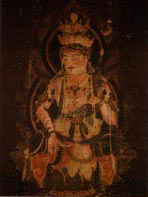"Tangible Cultural Properties" collectively refer to cultural products with a tangible form that possess high historic, artistic, and academic value to Japan, such as structures, paintings, crafts, sculptures, calligraphic works, classical books, paleography, archaeological artifacts, and historic materials. Within this category, all objects except for structures are called "fine arts and crafts."
The national government designates especially significant Tangible Cultural Properties as Important Tangible Cultural Properties among which ones with exceptionally high cultural values from the global perspective are designated as National Treasures to ensure protection.
Fine arts and crafts

National Treasure,
Eleven-Headed Kannon
(ink and colors on silk)
Owned by the Independent Administrative Institution,
National Institutes for Cultural Heritage
(Collection of the Nara National Museum)
The administration and restoration of a National Treasure or Important Cultural Property shall be carried out by its owner or administrative organization (the local government entity or other corporate entity recognized by the Commissioner for Cultural Affairs to appropriately administer the designated cultural property concerned). Out of the total number of works of fine arts and crafts that have been designated as National Treasures or Important Cultural Properties, approximately 60% are owned by shrines and Buddhist temples.
Alterations to the existing state of designated cultural properties are prohibited without approval. The export of designated cultural properties is prohibited, except when it has been approved after being judged necessary, as in the case of an overseas exhibition. The national government extends support for the conservation and restoration of designated cultural properties by providing state subsidies and other means, whereas the Commissioner for Cultural Affairs is authorized to give instructions on their administration, restoration, public display, and other related activities.







